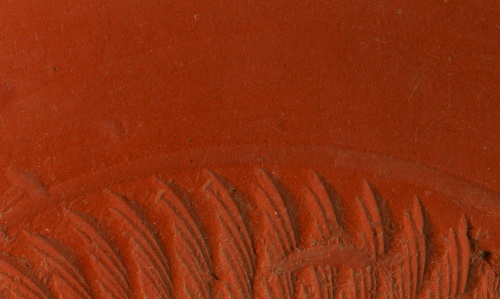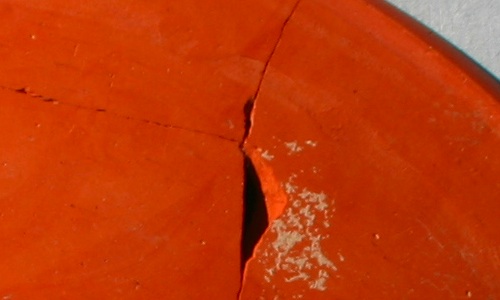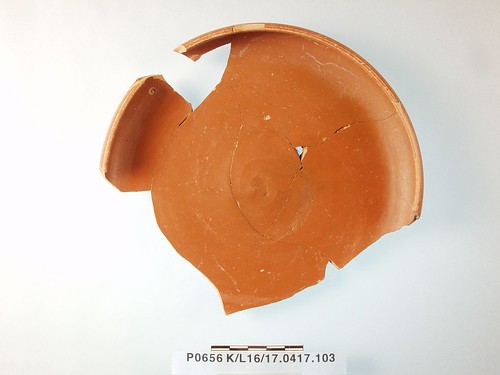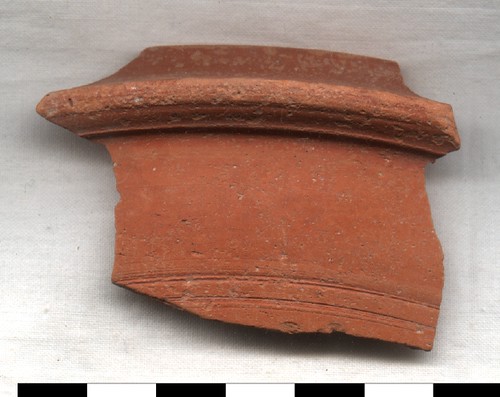The chronology of
Phocaean Red-Slip (LRC) Hayes forms 1 and 2 is turning out to be very important for the work Billur Tekkök and I are doing at Troy/Ilion, in particular when it comes to dating late 4th century building activity at the site. No real surprise there. In the grand scheme of things, Phocaea is near Troy so we should expect to have a fairly complete range of vessels, especially through the early to mid 6th century when the city is still in pretty good shape. An earthquake hits in c. 525 +/- and things seem to get rapidly worse after that. A few PRS Hayes form 10's and a little bit of African Red-Slip, including a Hayes 91d, show that there was ongoing activity at the site but it seems clear that things slow down over the course of the 6th century AD.
In terms of forms, we have lots of Hayes 1s, plenty of Hayes 2's, and many Hayes 3's. We also have a few 5's, vessels near form 6, 8's, a single 9, and a few 10's.
This post isn't about quantities so I'm intentionally using very vague terms. It is about chronology, or rather about the current thinking on the early chronology of the ware. It's just an opening shot so I hereby invoke all the informality that comes with a blog post.
Hayes defined the most widely used typology in 1972 in his
Late Roman Pottery (
worldcat). He described 10 forms with various subtypes and made frequent reference to his work at the Athenian Agora. Picking from his combination of explicit dating and narrative discussion gives the following date ranges for early PRS (p. 325-329):
| Hayes 1a | "late fourth-early fifth century." |
| Hayes 1b | "early-third quarter fifth century." |
| Hayes 1c | "uncertain, perhaps first half of fifth century" |
| Hayes 1d | "early-third quarter fifth century" |
| Hayes 2a | late fourth (370) to 450 |
| Hayes 2b | No explicit dates are given for the start of this variant, end falls under the general rubric that form 2 ends by 450. |
| Hayes 2c | Early variant, "with mid-late fourth century material". |
And while we're at it, here are some profile drawings:
Hayes 1a/b from Troy (I17.0647:5)

Hayes 2a from Troy (I17.0647:1)

For more examples go to
http://classics.uc.edu/troy/grbpottery/.
Since 1972, the start of form 2 has at times been moved later. This has been done partly on the basis of excavations at San Giacomo degli Schiavoni in Molise (Italy), which documented PRS from a rich early fifth-century cistern fill. The full reference is U.Albarella , V.Ceglia & P.Roberts,
S.Giacomo degli Schiavoni ( Molise ): an early fifth century AD deposit of pottery and animal bones from central Adriatic Italy. Papers of the British School at Rome, LXI, 157-230. I'm writing this from home but I do have a photocopy of that article. (Note: why isn't PBSR online? Really, it should be. Or is it and I just don't know about it.)
Jumping ahead a little bit, J. Hayes in his 2009 Agora volume on the imported fine-wares (about which more below), writes of this deposit that it is "coin-dated" (p. 85). Roberts in the article itself writes, "No coins were found, but abundant dating evidence was provided by imported finewares..." (p. 163). Earlier, Albarella writes, "Continuity of occupation through the Imperial period is well documented by and coins...". Question: is there a subsequent publication of a coin from (or clearly dating) the cistern fill? Hayes only references the PBSR article so may overstate the case by calling it "coin dated". Regardless, it's a large deposit (435 vessels identified), with various imports including 33 African Red-Slip (7.5%) and 13 PRS (3%). It certainly shows ARS and PRS circulating together in the early fifth century but I'm not sure it needs to be read as indicating a later start for Hayes 2.
I could offer more references, both to Albarella et al. and to other deposits but I'll instead return to Hayes 2009 (
worldcat). Pages 83-88 discuss PRS and offer a substantial update on the chronology presented in
LRP. To go along with the narrative, catalog entries 1229 to 1419 are all PRS and there are many profile drawings and a selection of photographs. It's a "don't miss" selection of information about the ware.
Looking to turn Hayes' prose into some relevant dates - some represented as numbers -, I come up with the following:
| First appearance of PRS in Agora | "...later fourth century, but regular importation seems to coincide with the marked slump seen here in African imports around 390-400... (p. 85) |
| Form 2 and 3 | Citing Italian and other sites, "it seems reasonable to conclude that the stamped forms 2 and 3 both originated close to the turn of the century as replacements for two popular African products..." (p. 85) |
| Form 3f and 3g | In Beirut earthquake horizon of 551.(p. 86) |
| beginning of Form 10 | "...the evidence from Lejjun (Jordan) hints at ca. 550..." (p. 86) |
| "...the continued presence of PRS ware until the mid-7th century seems assured..." (p. 86) | |
Those are just a few quotes from Hayes' prose introduction to the ware. Turning to the catalog, here are synopses of/snippets from some of the entries that stand out as useful for our work at Troy:
| 1230 | A "forerunner" to Hayes 1 dated to the late 3rd/early 4th. This piece is useful for documenting transition from Çandarli/ESC to PRS. |
| 1326 + 1327 | Form 1 variant. From "Grynnion" workshop? No join between sherds so perhaps not same vessel. "4th Century or later". |
| 1231 | Form 1 from "Context of second half of 4th century. |
| 1229 | Hayes 1. "Early(?) variant, in probable Çandarli fabric./Late 4th century. Context of Same date." |
| 1232-1236 | Main series of Hayes 1's, from first half of fifth or residual in later context. |
| 1237 | Hayes 2a from "Context of ca. A.D. 400. |
| 1238 | Hayes 2a dated "Ca. A.D. 400-425." |
| 1239 | Hayes 2a/b from "Context of ca. A.D. 400+." |
| 1240 | Hayes 2b "Date later than 1239? Context of ca. A.D. 460-475" |
| 1242 | Hayes 2c dated "Ca. A.D. 400 to mid-5th century." |
| 1243 | Hayes 2c from "Context of mid- to late 4th century." |
| 1244+1245 | Small Hayes 2's both from "Context of late 4th century." |
| 1246+1247 | Small Hayes 2's both dated to "Ca. A.D. 400 or later." |
I've assembled the above tables because when I read the prose introduction, I became concerned that the phrase "the stamped forms 2 and 3 both originated close to the turn of the century" could be become hardened into something like "forms 2 and 3 appear after 400." While this is true for Hayes form 3, I think the appearance of Hayes 2 needs to be kept a little earlier.
As noted, saying so goes against one stream of discussion of form 2. For example, when reviewing C. Abadie-Reynal's volume on the Roman pottery from Argos (
worldcat) for
BMCR, K. Slane wrote, "Recent work in Corinth confirms that LRC forms 1 and 2 are prevalent in the first half, perhaps even second quarter of the fifth century, rather than in the fourth." I quote the review first because it's readily available online. More in depth discussion can be found in two Hesperia articles: K. Slane and G. Sanders,
Corinth: Late Roman Horizons Hesperia 74 (2005), 243-297 (
online). To quote:
Assemblage 1 marks the earliest appearance of LRC at Corinth: Hayes forms 1 and 1A, 2B and C, 3.32, and 4 (or 3/4) appear in small quantities with coins of the second quarter and middle of the fifth century and with fifth-century AfRS. Although the amount of AfRS is sharply reduced from what it had been in the fourth century, it is still two or three times as common as LRC. (p. 283)
At the end of the same paragraph, assemblage 1 is dated to 450 or 460. By extension, LRC 1, 1a, 2b, 2c first appear at Corinth in 450 to 460.
In the catalog of this article no. 1.10 on page 251 and fig. 3 is a Hayes 2c similar in profile to Agora XXXII no. 1243, which is said to be from a "Context of mid- to late 4th century." So it looks like the first appearance of 2c at Corinth may post-date its appearance at Athens by 50 years. That's a big gap.
Slane has also published
The End of the Sanctuary of Demeter and Kore on Acrocorinth Hesperia 77 (2008), 465-496 (
online). The most relevant paragraph is the following:
No additional Late Roman C was identified in the reexamination of the context pottery. The single piece found in the sanctuary remains an intact saucer of form 1D (120, Fig. 2) from the debris overlying the floor of the Roman Propylon (lot 2240).Although progress has been made in establishing that LRC was manufactured at several sites south of Pergamon, including Phocaea,the published dates of LRC still depend heavily on the Athenian deposits.In the West, LRC is rare until ca. 470 and most common in the first half of the 6th century. Earlier forms appear ca. 430 in southern Italy (San Giovanni di Ruoti, San Giacomo degli Schiavoni), and the same forms appear at Benghazi. At Corinth, in the area north
of Buildings 1–7 east of the Theater, LRC forms 1 and 2 occur in approximately equal numbers with form 3B–C, suggesting that importation occurred through most of the 5th century; assemblage 1 from the same area contained form 2 and an early example of form 3.40 The most likely date for 120 therefore remains 425–460. Unfortunately, it is not from what we term “destruction debris.” Because it is intact, I had suggested that it was from one of the late graves, but none were identified so far west on the Middle Terrace. Perhaps it can be associated with the dismantling of the Roman Propylon, which would thus be dated ca. 430–460.
That's a long quote, I admit. But it makes for a good read and it is worth following the footnotes if you have access to the article online or in print. For my immediate purpose, it makes no definitive statements about the start of production of PRS Hayes 2, only about its appearance at Corinth.
As noted above, Slane's BMCR review is of the Roman pottery volume from Argos. What's is going on there. In her introduction to PRS, Abadie-Reynal writes:
La chronologie établie par J. W. Hayes parait généralement confirmée par les trouvailles ultérieure. La date d'apparition de cette production a été fixée dans la seconde moitié du IVe siècle, autour des années 370. Cette production continue jusqu'au VIIe siècle. (p. 176)
Catalog nos. 288, 289, and 290 (17.1.2-4) reference sherds of Hayes 2a, b and c from early fifth century deposits. Cat. no. 292 (17.2.2) is identified as the foot of a Hayes 2. Here's the discussion:
Un exemplaire provient d'un context daté de la fin du IVe siècle. Il est importante car c'est le seul fragment de la forme Hayes 2 qui ait été trouvé à Argos dans un contexte de cette époque. Il confirme donc bien que cette forme a commencé à être utilisée à la fin du IVe siècle, même si la majorité des fragments proviennent d'ensembles du Ve.
This offers a correction to Slane's statement in the BMCR review that "Abadie-Reynal is explicit that all examples of LRC form 2 are found in contexts of the fifth century or later, but a few examples of form 1 seem to be transitional from Çandarli." A foot is not as good evidence as a rim, however.
[Quickly checking the catalog of A. Ivantchik
Un puits d'époque paléochrétienne sur l'agora d'Argos BCH 126 (2002), 331-404 (
online), gives 2 Hayes 3's and a 4 of the mid-fifth.]
OK. What does all this have to do with Troy/Ilion? We have a Hayes 2 sealed in the construction of a columned portico that was added to an earlier building in the late fourth or early fifth century AD. It's the example illustrated above. The same deposit produced 2 Hayes 1a/b rims, a Hayes 1a base, an ARS H50, and an ARS H53b. I'm repeating two drawings from above, but here they all are together.
Hayes 1a from Troy (I17.0647:4)

Hayes 1a/b from Troy (I17.0647:5)

Hayes 1a base (I17.0648:6)

Hayes 2a from Troy (I17.0647:1)

Hayes African Red-Slip 50a (I17.0647:2)

Hayes African Red-Slip 53b (I17.0647:3)

It's a nice group and its date matters. Building the portico is part of a larger resurgence of activity after a lull in the fourth century. If things don't get going again until after 400, that affects our understanding of how quickly Ilion responded to large-scale phenomena such as the increasing population of Constantinople. Consider this and other issues local, regional and Mediterranean-wide and the date of PRS Hayes 2 matters. Especially if it's after 400 and is the latest dateable sherd in that deposit.
Right now, partly on the basis of I17.0647 and on the basis of the Argos catalog, I think Hayes 2 begins before 400. On a related matter, I think the transition from Çandarli to ESC is a smooth one and that Ilion, even if the fourth century isn't a high-point, continues to receive finewares from the south throughout this transition. But I'm adopting a somewhat informal tone in offering this initial conclusion because I've gathered the evidence as notes on secondary literature and as consideration of the material at Troy. I haven't pursued the dialectic between those sources to a firm end. I'm comfortable I've read pretty much everything but I need to do more photocopying/photographing so that I can get everything in front of me at the same time. More importantly, I think the work will be strengthened if I ask for comments now, so that's mostly what I'm doing.













